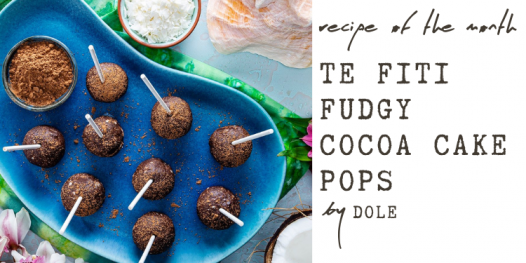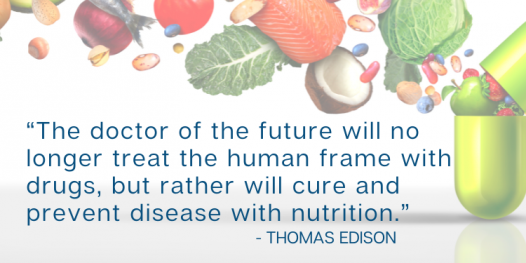I'm sure at one point or another, you have heard, read, or even said, "Let food be thy medicine, and let medicine be thy food." Initially stated by the famous Greek physician Hippocrates, this concept of food as medicine has been around since as early as 440 BC.
Yet, over 1500 years later, researchers and scientists are still working to understand how food serves as medicine.
If you've been curious about learning more about food as medicine, then you are in for a treat with this month's newsletter!
-Stephanie
|
|
|
Intro to Food As Medicine
|

In February 2021, the Academy of Nutrition and Dietetics Board of Directors approved the definition of Food as Medicine as a philosophy where food and nutrition aid individuals through interventions that support health and wellness.
Focus areas for Food as Medicine include:
- Food as preventative medicine to encourage health and well-being
- Food as medicine in disease management and treatment
- Food as medicine to improve nutrition security
- Food as medicine to promote food safety
And while 'food as medicine' might seem like an emerging concept in the Western world, the truth is, for centuries, food as medicine has served as a cornerstone of health for people around the globe. It's no secret that people with access to foods rich in nutrients have a stronger immune system and have a decreased risk of diabetes, cardiovascular disease, and cancer.
The Academy of Nutrition and Dietetics best summarizes the definition of Food as Medicine as a reaffirmation that food and nutrition play a role in sustaining health, preventing disease, and as a therapy for those with conditions or in situations responsive to changes in their diet.
Food as Medicine: In Practice
Focus on eating a variety of plant-based, minimally processed foods
Decrease consumption of foods with added sugar, oil, and salt, and limit intake of highly processed foods.
A few examples of using food as medicine include:
- Increase intake of dietary fiber for healthy proper digestion, and elimination, and to promote healthy blood sugar levels.
- Consume more foods rich in antioxidants to decrease the risk of heart disease and promote longevity.
- Eat foods rich in omega 3-fatty acids such as salmon and sardines for a healthy heart.
Sip on green tea to reduce inflammation.
Food as Medicine: Limitations
While there are many benefits to embracing food as medicine, knowing it is not a cure-all approach. Many factors are involved in chronic disease prevention and progression, including genetics, environment, and lifestyle.
With increased access to the internet and the spread of information and misinformation through social media, it is crucial to verify your sources.
If you are interested in adopting a food as medicine approach to your health goals, contact a registered dietitian and expert trained in the science of food and nutrition.
|
|
|
Healthy Body Essentials
|

Eye and Vision Health: vitamins A, E, and C
Food sources:
Vitamin A: leafy greens, yellow and orange vegetables, tomatoes, cantaloupe, and mango
Vitamin C: cantaloupe, citrus fruits like oranges, and broccoli
Vitamin E: nuts and seeds, including sunflower seeds, almonds, and peanuts
Bone Health: calcium, potassium, and magnesium
Food sources:
Calcium: soy, beans and legumes, and dark leafy greens like bok choy, Chinese cabbage, kale, figs, and collard greens
Potassium: avocados, sweet potatoes, potatoes, bananas, oranges
Magnesium: whole grains, dark green, leafy vegetables, lentils, peanuts, almonds, and cashews
Gut Health: fiber, probiotics, and prebiotics
Food sources:
Fiber: berries, apples, broccoli, barley, chickpeas, edamame, lentils, chia seeds, and oats
Probiotics: fermented foods such as yogurt, kefir, kombucha, and sauerkraut
Prebiotics: dandelion greens, garlic, onions, leeks, asparagus, bananas
|
|
Featured Recipe
Te Fiti Fudgy Cocoa Cake Pops
|

Recipe by Dole
Ingredients
- 1 DOLE® Banana, peeled
- 1 cup pitted dates
- ½ cup almond flour
- 3 tablespoons sunflower butter
- 2 tablespoons unsweetened cocoa powder plus additional for dusting (optional)
- ¼ cup gluten-free and vegan dark chocolate chips
- ¼ cup unsweetened coconut flakes
- 16 cake pop sticks
Directions
Line a rimmed baking pan with parchment paper. Pulse banana, dates, flour, sunflower butter, and cocoa powder in a food processor until smooth, scraping down the bowl occasionally. Add chocolate chips and coconut; pulse until incorporated. Transfer banana mixture to a medium bowl; freeze for 20 minutes or until firm. Makes about 1½ cups.
Form banana mixture into 16 (1½-inch) balls (about 1½ tablespoons each); insert cake pop sticks into the center of the balls. Transfer cake pops to prepared pan; freeze for 1 hour. Serve frozen dusted with cocoa powder, if desired. Makes 16 cake pops.
|
|
|
Be Inspired
|
|

|
|
|
About SO Nutrition
|
 Stephanie Leipprandt Ouellette, MBA, RDN, LD
Stephanie Leipprandt Ouellette, MBA, RDN, LD Stephanie has been working in the field of nutrition and dietetics since 1995. She earned a Bachelor of Science degree in Dietetics from Michigan State University, completed an Approved Pre-Professional Practice Program at Western Michigan University and earned a Master of Business Administration from Baker College. She’s been a Registered Dietitian Nutritionist since 1996 and licensed in Texas since 2007. In 2008, Stephanie earned her certification in Childhood and Adolescent Weight Management. Stephanie has extensive clinical & managerial experience, both in corporate settings and in the community. Now she wants to share her knowledge with you, because most (if not all) nutritional habits begin at home.
Stephanie and her family reside in Katy, Texas
|
|
| |
Copyright © 2022 Customized Nutrition Newsletters, All rights reserved.
|
|
| |
|
|